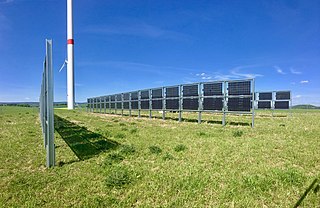Related Research Articles

Photovoltaics (PV) is the conversion of light into electricity using semiconducting materials that exhibit the photovoltaic effect, a phenomenon studied in physics, photochemistry, and electrochemistry. The photovoltaic effect is commercially used for electricity generation and as photosensors.

A solar cell or photovoltaic cell is an electronic device that converts the energy of light directly into electricity by means of the photovoltaic effect. It is a form of photoelectric cell, a device whose electrical characteristics vary when it is exposed to light. Individual solar cell devices are often the electrical building blocks of photovoltaic modules, known colloquially as "solar panels". Almost all commercial PV cells consist of crystalline silicon, with a market share of 95%. Cadmium telluride thin-film solar cells account for the remainder. The common single-junction silicon solar cell can produce a maximum open-circuit voltage of approximately 0.5 to 0.6 volts.

A solar panel is a device that converts sunlight into electricity by using photovoltaic (PV) cells. PV cells are made of materials that produce excited electrons when exposed to light. The electrons flow through a circuit and produce direct current (DC) electricity, which can be used to power various devices or be stored in batteries. Solar panels are also known as solar cell panels, solar electric panels, or PV modules.

SolarWorld is a German company dedicated to the manufacture and marketing of photovoltaic products worldwide by integrating all components of the solar value chain, from feedstock (polysilicon) to module production, from trade with solar panels to the promotion and construction of turn-key solar power systems. The group controls the development of solar power technologies at all levels in-house.
Sharp Solar, a subsidiary of Sharp Electronics, is a solar energy products company owned by Sharp Corporation and based in Osaka, Japan.
MiaSolé is an American solar energy company selling copper indium gallium selenide (CIGS) thin-film photovoltaic products. MiaSolé's manufacturing process lays CIGS on a flexible stainless steel substrate. MiaSolé produces all layers of photovoltaic material in a continuous sputtering process.

Yingli, formally Yingli Green Energy Holding Company Limited -. Yingli Green Energy Holding Company Limited, known as "Yingli Solar," is a solar panel manufacturer. Yingli Green Energy's manufacturing covers the photovoltaic value chain from ingot casting and wafering through solar cell production and solar panel assembly. Yingli's photovoltaic module capacity is 30 GWs.
Monocrystalline silicon, more often called single-crystal silicon, in short mono c-Si or mono-Si, is the base material for silicon-based discrete components and integrated circuits used in virtually all modern electronic equipment. Mono-Si also serves as a photovoltaic, light-absorbing material in the manufacture of solar cells.
China Concepts Stock is a set of stock of companies whose assets or earnings have significant activities in mainland China. The People's Republic of China is undergoing major financial transformation, and many leading mainland-based companies have chosen to list themselves overseas to gain access to foreign investor capital. Currently, there are China Concepts Stocks listed on several major stock exchanges around the globe, including the Hong Kong Stock Exchange (HKEx), Singapore Exchange (SGX), New York Stock Exchange (NYSE), NASDAQ, NYSE MKT, London Stock Exchange (LSE), Euronext, and the Tokyo Stock Exchange (TSE).
TEL Solar, formerly Oerlikon Solar, is a manufacturer of production equipment for the manufacturing of thin-film silicon cells, headquartered in Trübbach, Switzerland, near the border to Liechtenstein. The Japanese electronics and semiconductor company Tokyo Electron acquired the company of about 650 employees from OC Oerlikon in November 2012.

Thin-film solar cells are made by depositing one or more thin layers of photovoltaic material onto a substrate, such as glass, plastic or metal. Thin-film solar cells are typically a few nanometers (nm) to a few microns (μm) thick–much thinner than the wafers used in conventional crystalline silicon (c-Si) based solar cells, which can be up to 200 μm thick. Thin-film solar cells are commercially used in several technologies, including cadmium telluride (CdTe), copper indium gallium diselenide (CIGS), and amorphous thin-film silicon.

Between 1992 and 2023, the worldwide usage of photovoltaics (PV) increased exponentially. During this period, it evolved from a niche market of small-scale applications to a mainstream electricity source. From 2016-2022 it has seen an annual capacity and production growth rate of around 26%- doubling approximately every three years.
Topray Solar is a vertically integrated solar energy company with global presences in Africa, Europe, Asia and North America. It is a publicly listed company on China Shenzhen Stock Exchange with a market cap over 1 Billion USD. Topray Solar is a first-tier player in the renewable energy industry with multiple manufacturing bases and several oversea subsidiaries.

Crystalline silicon or (c-Si) Is the crystalline forms of silicon, either polycrystalline silicon, or monocrystalline silicon. Crystalline silicon is the dominant semiconducting material used in photovoltaic technology for the production of solar cells. These cells are assembled into solar panels as part of a photovoltaic system to generate solar power from sunlight.
Polycrystalline silicon, or multicrystalline silicon, also called polysilicon, poly-Si, or mc-Si, is a high purity, polycrystalline form of silicon, used as a raw material by the solar photovoltaic and electronics industry.

JinkoSolar Holding Co., Ltd. is a solar module manufacturer headquartered in Shanghai, China, and listed on the New York Stock Exchange since 2010. Its subsidiary Jinko Solar Co., Ltd. was listed on the Shanghai Stock Exchange's Science and Technology Innovation Board in 2022.
LONGi Green Energy Technology Co. Ltd. or LONGi Group (隆基股份), formerly Xi'an Longi Silicon Materials Corporation, is a Chinese photovoltaics company, a major manufacturer of solar modules and a developer of solar power projects.

A bifacial solar cell (BSC) is any photovoltaic solar cell that can produce electrical energy when illuminated on either of its surfaces, front or rear. In contrast, monofacial solar cells produce electrical energy only when photons impinge on their front side. Bifacial solar cells can make use of albedo radiation, which is useful for applications where a lot of light is reflected on surfaces such as roofs. The concept was introduced as a means of increasing the energy output in solar cells. Efficiency of solar cells, defined as the ratio of incident luminous power to generated electrical power under one or several suns (1 sun = 1000W/m2 ), is measured independently for the front and rear surfaces for bifacial solar cells. The bifaciality factor (%) is defined as the ratio of rear efficiency in relation to the front efficiency subject to the same irradiance.
Heterojunction solar cells (HJT), variously known as Silicon heterojunctions (SHJ) or Heterojunction with Intrinsic Thin Layer (HIT), are a family of photovoltaic cell technologies based on a heterojunction formed between semiconductors with dissimilar band gaps. They are a hybrid technology, combining aspects of conventional crystalline solar cells with thin-film solar cells.
References
- 1 2 Colville, Finlay (1 February 2019). "First Solar and [http://www.risenenergy.com Risen Energy] included in new SMSL for 2019". PV Tech. Retrieved 7 February 2022.
{{cite news}}: External link in|title= - ↑ "LONGi is the fastest growing PV manufacturer in the industry". April 2017.
- ↑ "GCL joins the exclusive Silicon Module Super League for 2016". 13 April 2016.
- 1 2 Colville, Finlay (2016-07-11). "Longi Silicon Materials becomes latest member of Silicon Module Super League". PV Tech. Retrieved 2024-06-06.
- ↑ Kenning, T. Trina sets new mono PERC cell efficiency record of 22.61%. PV Tech. Dec 19, 2016 1:16 PM GMT
- ↑ 22.61% (December 2016 record)/17% (December 2012 record) = 1.33 (a one-third improvement)
- ↑ PV Tech. Mark Osborne May 05, 2017 12:30 PM BST